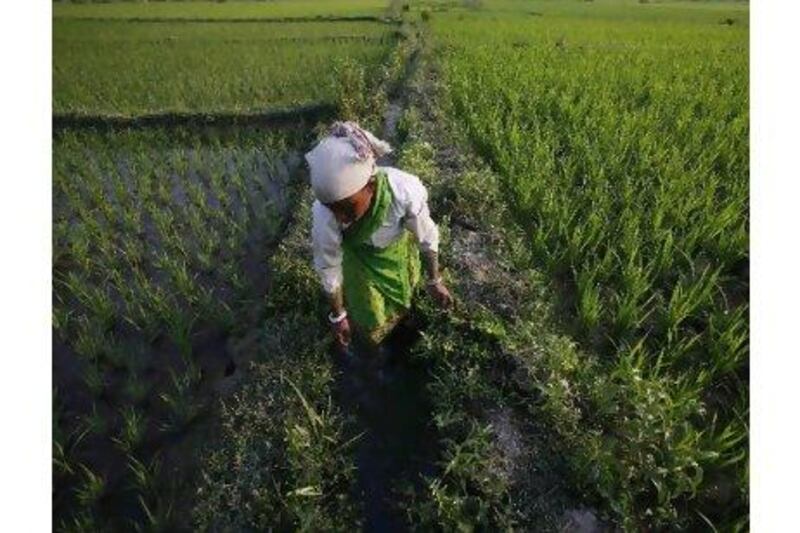NEW DELHI // Within the folds of a cautious budget, the Indian finance minister, Pranab Mukherjee, appeared to have accorded substantial importance to two key sectors, agriculture and elementary education, and to have fought against corrupted delivery mechanisms for government welfare.
A day after the presentation of the budget to the lower house of parliament, however, experts are suggesting that, in all three areas, Mr Mukherjee's budgetary schemes are weak or insufficient.
The emphasis on agriculture was important, as food prices in India have risen sharply during the past year.
The food inflation rate has hovered around 11 per cent throughout the first few months of 2011, and Mr Mukherjee called high food prices "the principal concern this year".
Accordingly, many of the budget announcements targeted the rural economy, which employs three out of five people in India.
A flagship programme called Bharat Nirman, which includes measures to improve electricity, irrigation, communications and drinking-water supplies in rural areas, was allocated US$2.2 billion (Dh8.08bn).
Banks will be required to lend nearly $105 billion to the agriculture sector, a 25 per cent increase from the country's 2010-11 budget.
The government also earmarked $3.28bn for agriculture and allied sectors, a 2.6 per cent increase compared to last year's figure.
Additionally, the budget includes interest-rate subsidies for farmers and a promise to table a food security bill in parliament later this year.
Himanshu, an economics professor at Jawaharlal Nehru University who uses only one name, called the budget "limited in scope".
The budgets presented in 2004-05 and 2007-08 had improved agriculture by investing heavily in infrastructure, he said, and he refused to put this latest budget in the same category.
"In Bharat Nirman, irrigation is the only component that impacts agriculture, and the allocation to that specifically has not risen by very much," Professor Himanshu said.
What the budget should have done, he added, was to provide policy direction and more incentives for farmers. "Farmers need adequate policy signals that they're not vulnerable."
Other experts agreed. MS Swaminathan, an agricultural scientist and one of the architects of India's Green Revolution in the 1960s, writing in The Hindu newspaper, also said the budget lacked "a strategy for keeping farmers on the farm".
Mr Mukherjee said the government would spend an additional $1.3bn on Sarva Shiksha Abhiyan, a programme that guarantees elementary education to all children.
But Madhav Chavan, the president and chief executive of Pratham, India's largest NGO in the education sector, called this "sleight-of-hand".
Mr Mukherjee compared the expenditure of $4.6bn to the $3.3bn that was earmarked for the Sarva Shiksha Abhiyan last year. However, another $900 million had been added to the scheme by parliament, so the comparison should really have been to $4.2bn, Mr Chavan said.
"Really, then, those figures aren't even adjusted for inflation," Mr Chavan said.
He also said the increase was funded entirely by the levy of a special education tax, "whereas that tax was only partially supposed to fund such increases and the government was supposed to find money elsewhere for the Sarva Shiksha Abhiyan".
"This is unbecoming, and it'll just slow down the implementation of the act."
Having noted, early in his speech, the "drift in governance and a gap in public accountability", Mr Mukherjee proposed the provision of direct cash transfers to the poor, instead of the present system of subsidising fuel and fertiliser.
Cash transfers are common in countries such as Brazil, Indonesia and Chile, and are thought to circumvent the leakages of benefits as they filter down through a corrupted chain of delivery. Subsidised kerosene, for instance, is often sold by intermediaries on the black market.
But Yamini Aiyar, the director of the Accountability Initiative at the Centre for Policy Research, a Delhi-based think tank, said: "How are you going to decide whom to give these cash payments to, if you can't decide who the poor of India are? We can't figure out who in the population is below the poverty line, so how can you assume that this cash transfer will work?"
The criteria to identify Indians living below the poverty line has often been criticised for not being robust enough, and the process of issuing so-called Below Poverty Line cards has often been subject to corruption and mismanagement.
Ms Aiyar admitted that Mr Mukherjee had envisioned such transfers to be linked to the UID scheme, a system for assigning unique identification to every Indian citizen, which was launched in 2009. "But a fully UID-enabled India is still 10 years away," she said.
With cash transfers in lieu of fertiliser subsidies, Professor Himanshu said, the deficiencies of the administrative system still pose problems. "It's impossible to target the people who need the cash," he said. "The small and marginal farmers are the ones who are really stuck in agriculture, who need the money and have these problems. But very often they don't have proper land records, so they'll lose out. It all looks very good in theory, but they just won't get the money."
[ ssubramanian@thenational.ae ]





